Table Citroen GRAND C4 PICASSO 2017 2.G Owner's Guide
[x] Cancel search | Manufacturer: CITROEN, Model Year: 2017, Model line: GRAND C4 PICASSO, Model: Citroen GRAND C4 PICASSO 2017 2.GPages: 527, PDF Size: 12.91 MB
Page 149 of 527
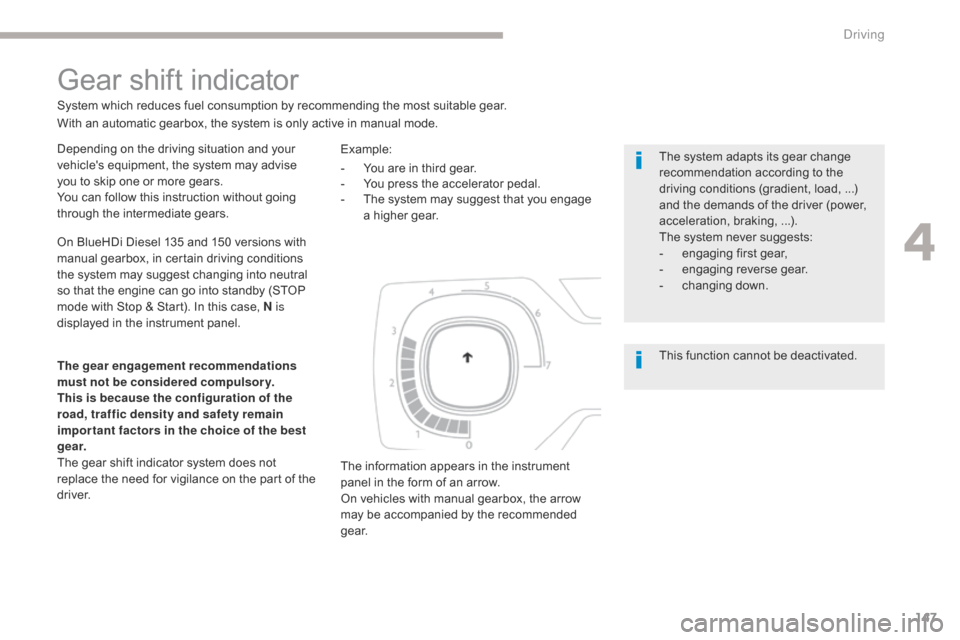
147
C4-Picasso-II_en_Chap04_conduite_ed02-2016
Depending on the driving situation and your
vehicle's equipment, the system may advise
you to skip one or more gears.
You can follow this instruction without going
through the intermediate gears.
Gear shift indicator
System which reduces fuel consumption by recommending the most suitable gear.The system adapts its gear change
recommendation according to the
driving conditions (gradient, load,
...)
and the demands of the driver (power,
acceleration, braking,
...).
The system never suggests:
-
e
ngaging first gear,
-
enga
ging reverse gear.
-
c
hanging down.
The information appears in the instrument
panel in the form of an arrow.
On vehicles with manual gearbox, the arrow
may be accompanied by the recommended
g e a r.
The gear engagement recommendations
must not be considered compulsory.
This is because the configuration of the
road, traffic density and safety remain
impor tant factors in the choice of the best
g e a r.
The gear shift indicator system does not
replace the need for vigilance on the part of the
driver. With an automatic gearbox, the system is only active in manual mode.
On BlueHDi Diesel 135 and 150 versions with
manual gearbox, in certain driving conditions
the system may suggest changing into neutral
so that the engine can go into standby (STOP
mode with Stop & Start). In this case, N is
displayed in the instrument panel. Example:
This function cannot be deactivated.
-
Y
ou are in third gear.
-
Y
ou press the accelerator pedal.
-
T
he system may suggest that you engage
a higher gear.
4
Driving
Page 150 of 527
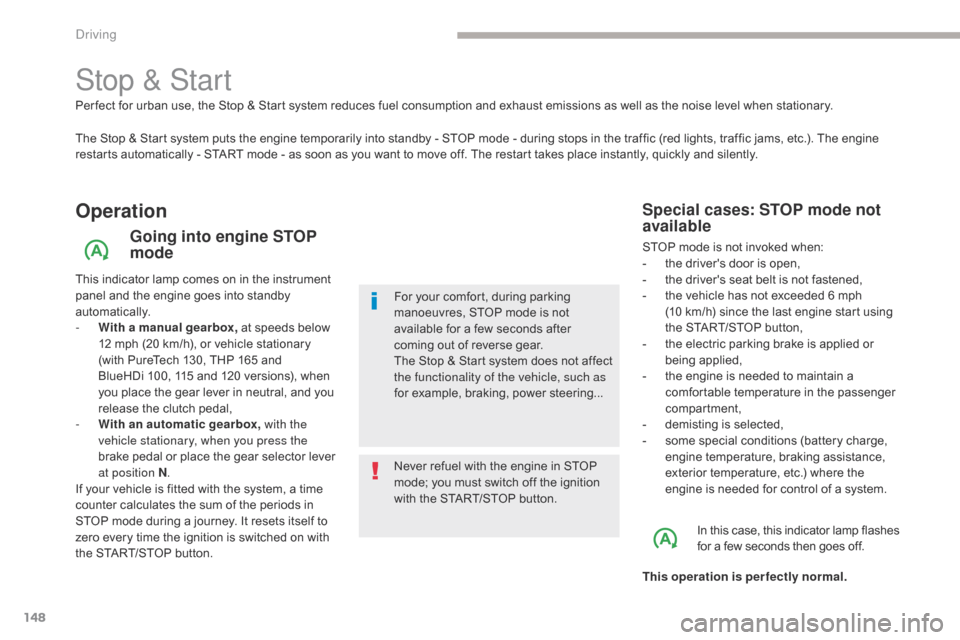
148
C4-Picasso-II_en_Chap04_conduite_ed02-2016
Stop & Start
The Stop & Start system puts the engine temporarily into standby - STOP mode - during stops in the traffic (red lights, traffic jams, etc.). The engine
restarts automatically - START mode - as soon as you want to move off. The restart takes place instantly, quickly and silently.
Operation
Going into engine STOP
mode
This indicator lamp comes on in the instrument
panel and the engine goes into standby
automatically.
-
W
ith a manual gearbox, at speeds below
12 mph (20 km/h), or vehicle stationary
(with PureTech 130, THP 165 and
BlueHDi
100, 115 and 120 versions), when
you place the gear lever in neutral, and you
release the clutch pedal,
-
Wi
th an automatic gearbox, with the
vehicle stationary, when you press the
brake pedal or place the gear selector lever
at position N .
If your vehicle is fitted with the system, a time
counter calculates the sum of the periods in
STOP mode during a journey. It resets itself to
zero every time the ignition is switched on with
the START/STOP button. Never refuel with the engine in STOP
mode; you must switch off the ignition
with the START/STOP button. For your comfort, during parking
manoeuvres, STOP mode is not
available for a few seconds after
coming out of reverse gear.
The Stop & Start system does not affect
the functionality of the vehicle, such as
for example, braking, power steering...
Special cases: STOP mode not
available
STOP mode is not invoked when:
-
t he driver's door is open,
-
t
he driver's seat belt is not fastened,
-
t
he vehicle has not exceeded 6 mph
(10
km/h) since the last engine start using
the START/STOP button,
-
t
he electric parking brake is applied or
being applied,
-
t
he engine is needed to maintain a
comfortable temperature in the passenger
compartment,
-
d
emisting is selected,
-
s
ome special conditions (battery charge,
engine temperature, braking assistance,
exterior temperature, etc.) where the
engine is needed for control of a system.
In this case, this indicator lamp flashes
for a few seconds then goes off.
This operation is perfectly normal.
Per fect for urban use, the Stop & Start system reduces fuel consumption and exhaust emissions as well as the noise level when stationary.
Driving
Page 151 of 527
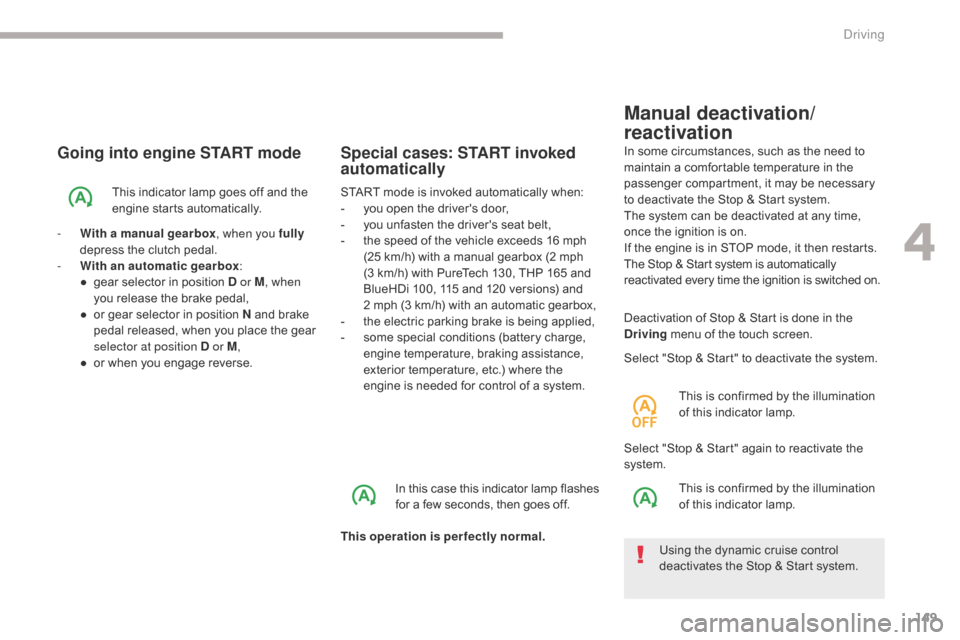
149
C4-Picasso-II_en_Chap04_conduite_ed02-2016
Going into engine START mode
This indicator lamp goes off and the
engine starts automatically.
-
W
ith a manual gearbox , when you fully
depress the clutch pedal.
-
W
ith an automatic gearbox :
●
g
ear selector in position D or M , when
you release the brake pedal,
●
o
r gear selector in position N and brake
pedal released, when you place the gear
selector at position D or M ,
●
o
r when you engage reverse. START mode is invoked automatically when:
-
y ou open the driver's door,
-
y
ou unfasten the driver's seat belt,
-
t
he speed of the vehicle exceeds 16 mph
(25 km/h) with a manual gearbox (2 mph
(3 km/h) with PureTech 130, THP 165 and
BlueHDi 100, 115 and 120 versions) and
2
mph (3 km/h) with an automatic gearbox,
-
t
he electric parking brake is being applied,
-
s
ome special conditions (battery charge,
engine temperature, braking assistance,
exterior temperature, etc.) where the
engine is needed for control of a system.
Special cases: START invoked
automaticallyIn some circumstances, such as the need to
maintain a comfortable temperature in the
passenger compartment, it may be necessary
to deactivate the Stop & Start system.
The system can be deactivated at any time,
once the ignition is on.
If the engine is in STOP mode, it then restarts.
The Stop & Start system is automatically
reactivated every time the ignition is switched on.
Manual deactivation/
reactivation
In this case this indicator lamp flashes
for a few seconds, then goes off.
This operation is perfectly normal. Select "Stop & Start" to deactivate the system.
This is confirmed by the illumination
of this indicator lamp.
Using the dynamic cruise control
deactivates the Stop & Start system.
Deactivation of Stop & Start is done in the
Driving
menu of the touch screen.
Select "Stop & Start" again to reactivate the
system. This is confirmed by the illumination
of this indicator lamp.
4
Driving
Page 159 of 527
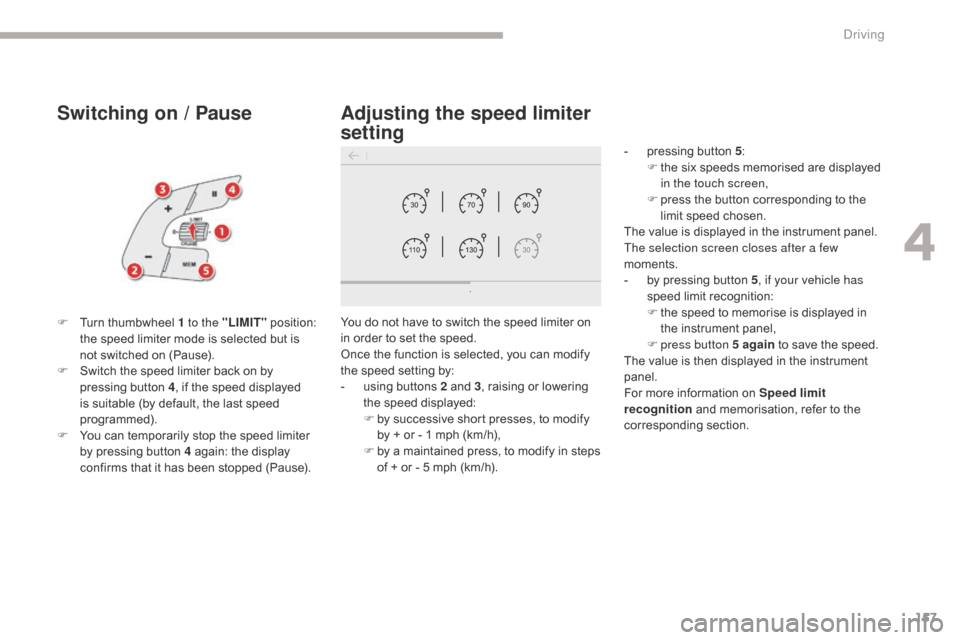
157
C4-Picasso-II_en_Chap04_conduite_ed02-2016
Switching on / Pause
F Turn thumbwheel 1 to the "LIMIT" position:
the speed limiter mode is selected but is
not switched on (Pause).
F
S
witch the speed limiter back on by
pressing button 4 , if the speed displayed
is suitable (by default, the last speed
programmed).
F
Y
ou can temporarily stop the speed limiter
by pressing button 4 again: the display
confirms that it has been stopped (Pause). You do not have to switch the speed limiter on
in order to set the speed.
Once the function is selected, you can modify
the speed setting by:
-
u
sing buttons 2 and 3, raising or lowering
the speed displayed:
F
b
y successive short presses, to modify
by + or - 1 mph (km/h),
F
b
y a maintained press, to modify in steps
of + or - 5 mph (km/h).
Adjusting the speed limiter
setting
- pressing button 5 :
F t he six speeds memorised are displayed
in the touch screen,
F
p
ress the button corresponding to the
limit speed chosen.
The value is displayed in the instrument panel.
The selection screen closes after a few
moments.
-
b
y pressing button 5 , if your vehicle has
speed limit recognition:
F
t
he speed to memorise is displayed in
the instrument panel,
F
press button 5 again to save the speed.
The value is then displayed in the instrument
panel.
For more information on Speed limit
recognition and memorisation, refer to the
corresponding section.
4
Driving
Page 167 of 527

165
C4-Picasso-II_en_Chap04_conduite_ed02-2016
In the event of the presence of a
vehicle detected by the radar, if the
speed selected is much higher than
the speed of that vehicle, the system
is not activated and the alert message
"Activation not possible, conditions
unsuitable" is displayed until driving
conditions are safe to allow activation of
the system.
Exceeding the speed setting
The information is grouped together in the
instrument panel.
6.
I
ndication of cruise control pause/resume.
7.
I
ndication of selection of cruise control
mode, or
v
ehicle speed adjustment phase.
8.
C
ruise speed setting, or
a
djusted speed lower than the cruise
setting.
Displays in the instrument panel
Modification of the inter-vehicle
distance
Press button 6 to choose a new inter-vehicle
distance setting from the 3 available (" Close",
" Normal ", "Distant ").
This value remains in memory, whatever the
state of the system.
It is possible to exceed the speed setting
temporarily by depressing the accelerator
pedal.
Then simply release the accelerator pedal to
return to the programmed speed.
If the speed setting is unintentionally exceeded,
descending a steep hill for example, the speed
setting in the instrument panel flashes as a
warning.
4
Driving
Page 168 of 527
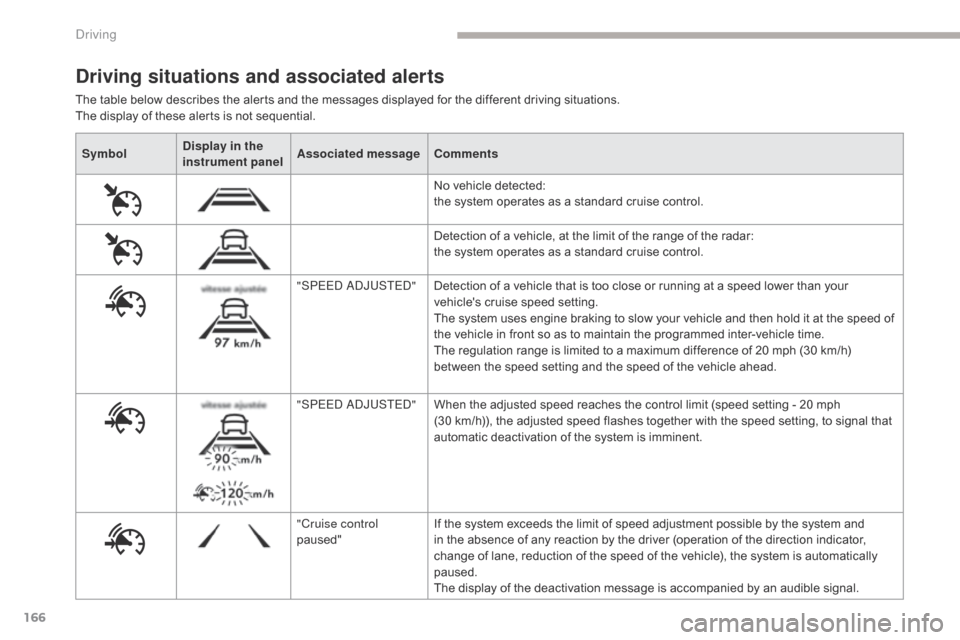
166
C4-Picasso-II_en_Chap04_conduite_ed02-2016
SymbolDisplay in the
instrument panel Associated message
Comments
No vehicle detected:
the system operates as a standard cruise control.
Detection of a vehicle, at the limit of the range of the radar:
the system operates as a standard cruise control.
"SPEED ADJUSTED" Detection of a vehicle that is too close or running at a speed lower than your
vehicle's cruise speed setting.
The system uses engine braking to slow your vehicle and then hold it at the speed of
the vehicle in front so as to maintain the programmed inter-vehicle time.
The regulation range is limited to a maximum difference of 20 mph (30 km/h)
between the speed setting and the speed of the vehicle ahead.
"SPEED ADJUSTED" When the adjusted speed reaches the control limit (speed setting - 20 mph
(30
km/h)), the adjusted speed flashes together with the speed setting, to signal that
automatic deactivation of the system is imminent.
"Cruise control
paused" If the system exceeds the limit of speed adjustment possible by the system and
in the absence of any reaction by the driver (operation of the direction indicator,
change of lane, reduction of the speed of the vehicle), the system is automatically
paused.
The display of the deactivation message is accompanied by an audible signal.
Driving situations and associated alerts
The table below describes the alerts and the messages displayed for the different driving situations.
The display of these alerts is not sequential.
Driving
Page 169 of 527
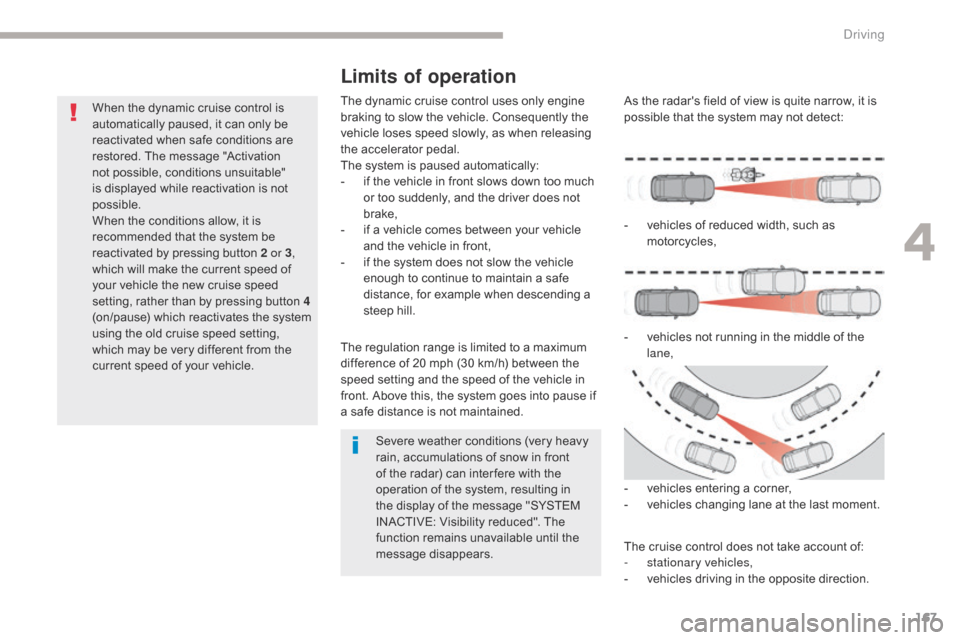
167
C4-Picasso-II_en_Chap04_conduite_ed02-2016
When the dynamic cruise control is
automatically paused, it can only be
reactivated when safe conditions are
restored. The message "Activation
not possible, conditions unsuitable"
is displayed while reactivation is not
possible.
When the conditions allow, it is
recommended that the system be
reactivated by pressing button 2 or 3,
which will make the current speed of
your vehicle the new cruise speed
setting, rather than by pressing button 4
(on/pause) which reactivates the system
using the old cruise speed setting,
which may be very different from the
current speed of your vehicle. The dynamic cruise control uses only engine
braking to slow the vehicle. Consequently the
vehicle loses speed slowly, as when releasing
the accelerator pedal.
The system is paused automatically:
-
i
f the vehicle in front slows down too much
or too suddenly, and the driver does not
brake,
-
i
f a vehicle comes between your vehicle
and the vehicle in front,
-
i
f the system does not slow the vehicle
enough to continue to maintain a safe
distance, for example when descending a
steep hill.
Limits of operation
As the radar's field of view is quite narrow, it is
possible that the system may not detect:
The cruise control does not take account of:
-
s
tationary vehicles,
-
v
ehicles driving in the opposite direction.
-
v
ehicles of reduced width, such as
motorcycles,
-
v
ehicles not running in the middle of the
lane,
-
v
ehicles entering a corner,
-
v
ehicles changing lane at the last moment.
The regulation range is limited to a maximum
difference of 20 mph (30 km/h) between the
speed setting and the speed of the vehicle in
front. Above this, the system goes into pause if
a safe distance is not maintained.
Severe weather conditions (very heavy
rain, accumulations of snow in front
of the radar) can inter fere with the
operation of the system, resulting in
the display of the message "SYSTEM
INACTIVE: Visibility reduced". The
function remains unavailable until the
message disappears.
4
Driving
Page 174 of 527
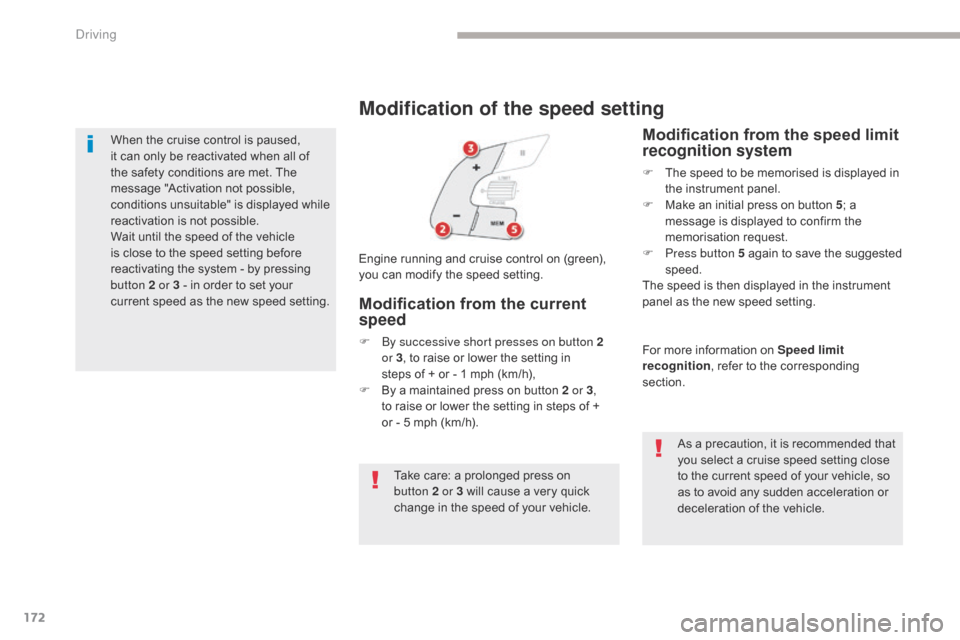
172
C4-Picasso-II_en_Chap04_conduite_ed02-2016
When the cruise control is paused,
it can only be reactivated when all of
the safety conditions are met. The
message "Activation not possible,
conditions unsuitable" is displayed while
reactivation is not possible.
Wait until the speed of the vehicle
is close to the speed setting before
reactivating the system - by pressing
button 2 or 3 - in order to set your
current speed as the new speed setting.
Modification of the speed setting
Modification from the speed limit
recognition system
F The speed to be memorised is displayed in the instrument panel.
F
M
ake an initial press on button 5 ; a
message is displayed to confirm the
memorisation request.
F
P
ress button 5 again to save the suggested
speed.
The speed is then displayed in the instrument
panel as the new speed setting.
As a precaution, it is recommended that
you select a cruise speed setting close
to the current speed of your vehicle, so
as to avoid any sudden acceleration or
deceleration of the vehicle.
For more information on Speed limit
recognition
, refer to the corresponding
section.
Engine running and cruise control on (green),
you can modify the speed setting.
Modification from the current
speed
F By successive short presses on button 2
or 3, to raise or lower the setting in
steps of + or - 1 mph (km/h),
F
B
y a maintained press on button 2 or 3 ,
to raise or lower the setting in steps of +
or
- 5 mph (km/h).
Take care: a prolonged press on
button
2 or 3 will cause a very quick
change in the speed of your vehicle.
Driving
Page 176 of 527

174
70
70
C4-Picasso-II_en_Chap04_conduite_ed02-2016
Driving situations and associated alerts
To benefit from all of the information available in the instrument panel, you must first select the "DRIVING" display mode.
The following table describes the alerts and the messages displayed for the different driving situations.
The display of these alerts is not sequential.Indicator Display Associated messageComment
according to the inter-vehicle
distance selected "Cruise control paused" System paused.
No vehicle detected.
according to the inter-vehicle
distance selected "Cruise control paused" System paused.
A vehicle has been detected.
according to the inter-vehicle
distance selected "Cruise control on"
System activated.
No vehicle detected.
according to the inter-vehicle
distance selected "Cruise control on"
System activated.
A vehicle has been detected.
or "Cruise control suspended"
System activated.
The driver has temporarily taken control of the vehicle by
accelerating.
Driving
Page 177 of 527
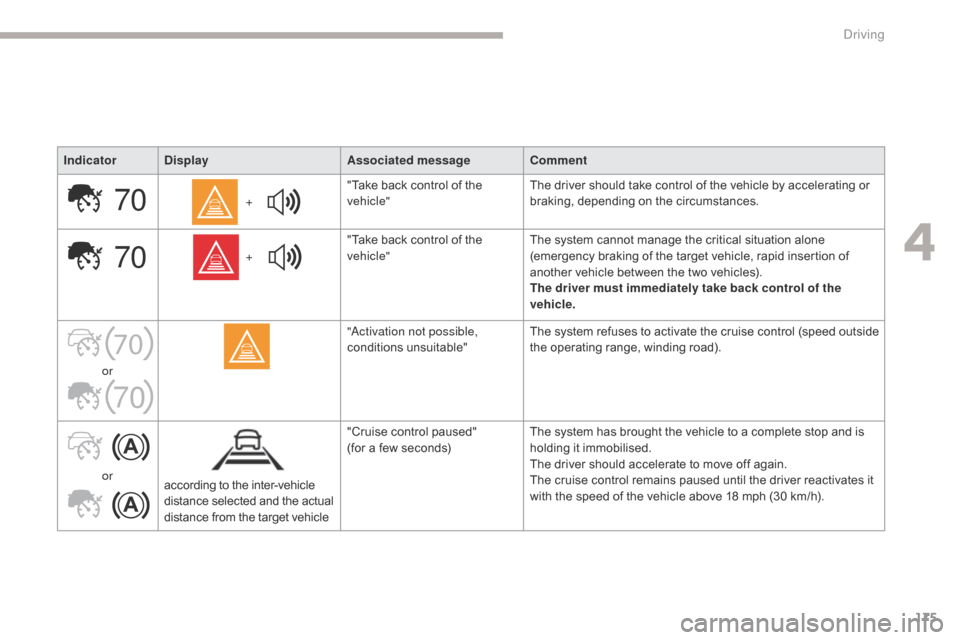
175
70
70
70
70
C4-Picasso-II_en_Chap04_conduite_ed02-2016
IndicatorDisplay Associated messageComment
+ "Take back control of the
vehicle"
The driver should take control of the vehicle by accelerating or
braking, depending on the circumstances.
+ "Take back control of the
vehicle"
The system cannot manage the critical situation alone
(emergency braking of the target vehicle, rapid insertion of
another vehicle between the two vehicles).
The driver must immediately take back control of the
vehicle.
or "Activation not possible,
conditions unsuitable"
The system refuses to activate the cruise control (speed outside
the operating range, winding road).
or according to the inter-vehicle
distance selected and the actual
distance from the target vehicle "Cruise control paused"
(for a few seconds)
The system has brought the vehicle to a complete stop and is
holding it immobilised.
The driver should accelerate to move off again.
The cruise control remains paused until the driver reactivates it
with the speed of the vehicle above 18 mph (30 km/h).
4
Driving